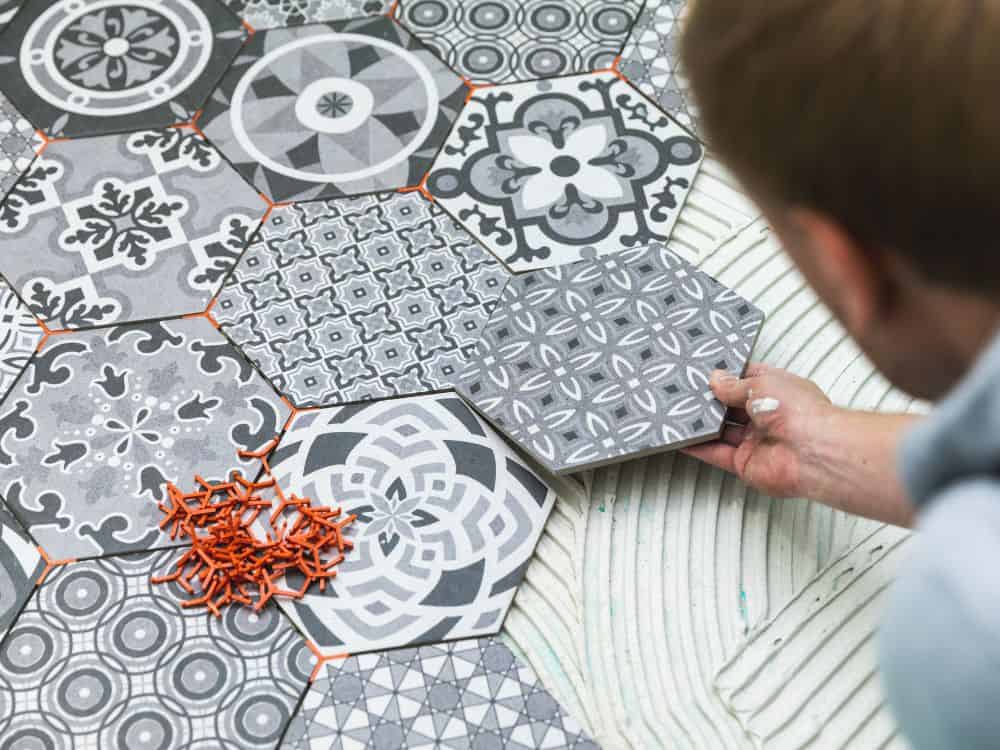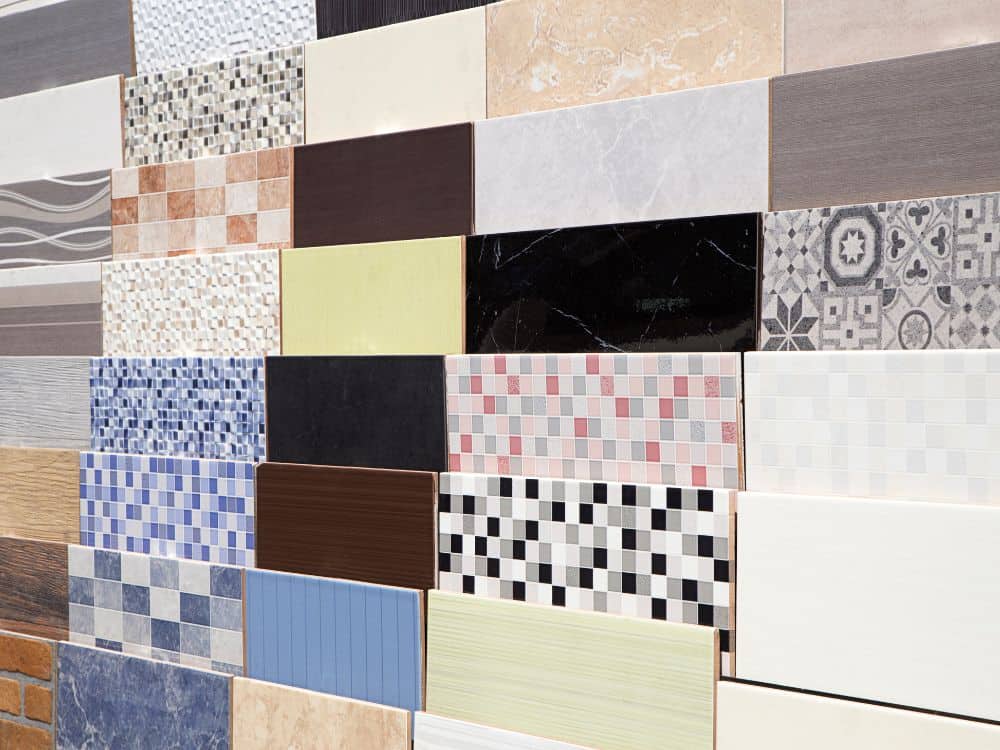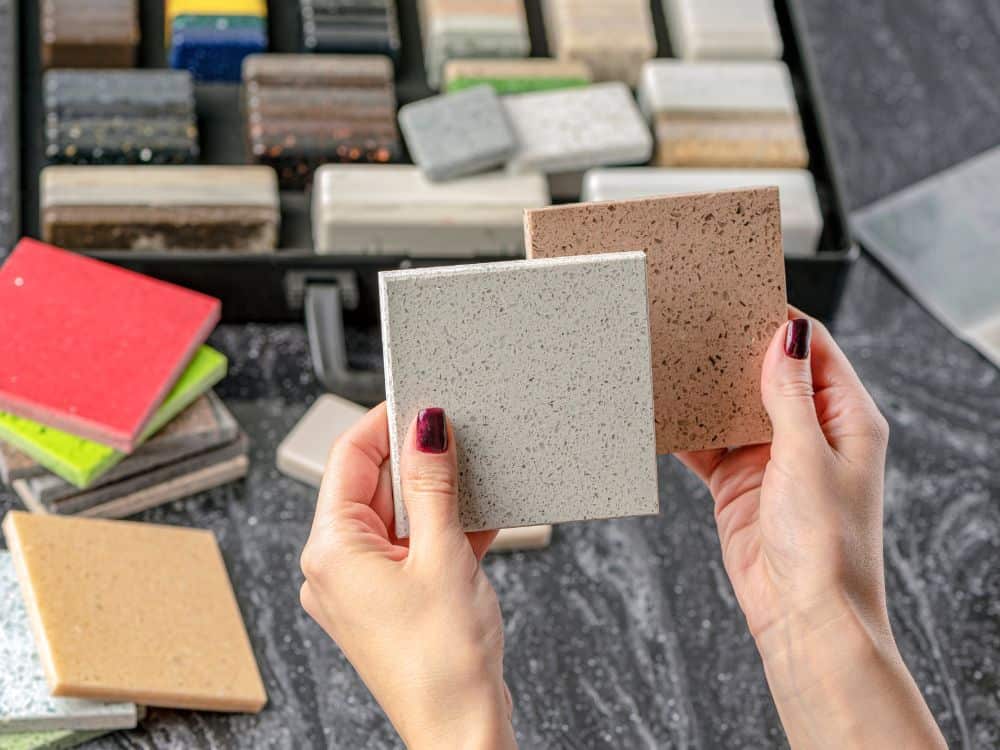There are many variables to consider with floor tiles, but one that’s often overlooked is tile thickness. Even a small mistake can cause major issues in a new build or a remodel, and understanding standard thickness can help you plan accordingly.
Floor tiles can be anywhere from a few millimeters to 1 ½ inches thick, although most measure between ⅜ and 1 inch. The size differs depending on the tile material, its other dimensions, and the needed functionality of the tile.
In this article, we explain how these variables affect tile thickness, details you should pay attention to, and where most make mistakes.
Table of Contents
Floor Tile Thickness Based on Material
The first major indicator of tile thickness is material. Different types of tiles rely on different materials to offer a blend of durability and appearance to match your budget and vision.
| Tile Material | Tile Thickness |
| Vinyl | 2 to 8 mm |
| Ceramic | ¼ to ½ inch |
| Slate | ¼ to ½ inch |
| Porcelain | ¼ to ¾ inch |
The source material may become brittle if it’s too thin, or it may be more economical to keep the tile a certain thickness. In turn, this also affects the cost of the tile as well as where it’s best suited in your home.
Vinyl
Vinyl tiles are usually the thinnest option available, and you see them measured in millimeters instead of inches to highlight this difference.
Despite their thin build, vinyl floor tiles are made from highly-durable PVC and are a popular option for temporary or low-cost changes in a household. They’re most often seen in peel-and-stick or interlocking forms, and work well with DIY projects.
Vinyl tiles can have an unpredictable life span depending on traffic and environmental conditions.
Porcelain
Porcelain tiles have the greatest width range, and they’re a popular choice in both commercial and residential areas. They’re made by heating a mix of clays and minerals, resulting in a harder and denser tile capable of handling high-traffic areas.
Porcelain looks great, and it resists common issues such as staining, moisture, bacteria, scratches, and odors. You also get several color and texture options with porcelain that you won’t see with other tile options.
Ceramic
Ceramic tiles are a popular choice because they hold up well and are easy to maintain. Their water-resistant nature means you see them most often in bathrooms, kitchens, laundry rooms, and areas of high humidity.
Ceramic tiles come in a wide variety of styles, colors, and textures, and their general thickness range reflects this. The thicker the tile is, the more durable it becomes.
Slate
Slate tiles are made using a combination of metamorphic rock (including quartz, mica, chloride, and calcite). Slate is a hard stone, meaning it doesn’t need to be very thick to hold up under residential or commercial traffic.
While most slate tiles have a ¼ to ½ inch thickness, they require a medium bed mortar for proper support. While other mortar beds may shrink as they cure, a medium bed will hold its form and easily add another ¾ inch to the tile height.
Floor Tile Thickness Based on Size
While material plays a major role in a tile’s size, its other dimensions also influence the thickness of a tile.
| Size/ Function | Thickness |
| Decorative tiles (mosaics or backsplashes) | 2 to 8 mm |
| Small tiles (in the bathroom or border tiles) | ¼ inch |
| Medium tiles (residential flooring in bedrooms or hallways) | ¼ to ½ inch |
| Large tiles (residential flooring in high-traffic or humid areas) | ½ to ¾ inch |
| Extra large tiles (used outdoors or in commercial areas) | ⅝ to 1+ inch |
As you can see, tile thickness usually increases with the surface area of the tile. The exception here are vinyl tiles or other peel-and-stick variants that can get by with a thinner form.
Decorative Tiles
Decorative tiles are often used in art installations, such as mosaic tiles, or as backsplashes, such as subway tiles. Because these areas are highly unlikely to have much foot traffic, these tiles can be much thinner without consequence.
Other examples of thinner tiles used for decoration include adhesive wall tiles and glass tiles. By using thinner tiles in low-traffic areas, you can improve the visual appeal of your home without throwing more money at the project.
Small Tiles
Smaller tiles are often used to border other sizes or in bathrooms. These smaller tiles may be a similar size to the ones used as decoration in your home (such as backsplash tiles), but they must be thicker to handle increased traffic in the area.
For example, shower tiles must be thick enough to hold up against daily water exposure, but they must also be thin to reduce weight in this area. The tiles on your bathroom floors may be small so it matches your shower walls and presents a cohesive image in your home.
Medium Tiles
Medium tiles are common in most residential areas, and most tiles fall into this size regardless of material. These tiles must be thin enough that you can lay them all over your home, but thick enough to hold strong against the traffic in your home.
Most medium sized tiles can hold up to heavy traffic in areas such as entryways or hallways without being too large for such a thin passage.
Large Tiles
Some homes use larger tiles with a higher typical thickness in special areas such as the kitchen or basement. Tile material may also differ in these areas to accommodate a lower or higher temperature or level of humidity.
Extra Large Tiles
Extra large tiles may have a greater surface area, or they may simply be thicker to handle extenuating circumstances. You see these most often with outdoor tiles, such as pavers, or tiles for heavy public traffic.
Pay Attention to Millimeters and Inches
Most tiles list their thickness in millimeters or inches, but you should pay close attention to any listed measurements.
In general, tiles that list thickness in millimeters will be very thin, but this isn’t a hard fast rule. It only takes a little over 6 millimeters to equal a quarter inch.
Considering Underlayment
Underlayment thickness should be on your mind when choosing tile thickness for your home. This includes:
- Backers
- Adhesive
- Underlayment
Different tiles require different subfloors, and some need leveling compounds or adhesives that can increase their height on the floor. Some areas require special backings, such as moisture barriers, that tag more on.
They may seem like small changes, but adding ⅝ inch of tile on a ⅛ inch of underlayment changes the height to ¾ inch. Small changes matter quite a bit when other aspects in your home depend on them, as you’ll see in the next section.
Why Tile Thickness Matters
Just as tile thickness derives from certain factors, it affects and influences different details in your home-owning experience. The most obvious are:
- Your budget/ tile cost
- The durability of the tile
- Door height
- The position of the baseboard in the home
- Transitions in the home
Choosing the wrong tile thickness or forgetting to add height for underlayment can bleed into these areas.
Cost
The most obvious reason to pay attention to tile thickness involves its cost.
Thicker tiles of the same surface size and material will cost more because they use more material. This may be a small difference when you look at the per-unit price, but it becomes obvious when you buy enough to tile your home.
Beyond this, buying the wrong tile width can cost you in other ways. If you’re able to return the tiles, you may not get the full amount refunded or you may be required to cover return shipping.
If your custom ordered these tiles, you may not be able to return the tiles at all, meaning you need to find a way to use them or consider the whole lot a cost. Even if you do use them, you may need to spend more to rework other aspects of your home such as your door or baseboard height.
Durability
Just as ordering tiles that are too thick can cost you in the short term, installing tiles that are too thin can cost you more later on. This is especially important for homes or buildings that expect a high volume of traffic.
The goal is to get a tile that is the perfect fit for your space so you will not need to replace them anytime soon.
Doors, Baseboards, and Transitions
Unless you use tile with the exact thickness as the previous floor, you must adjust these aspects in your home. Small differences may not be obvious, but bigger ones can be eyesores, interfere with the functionality of these areas, and be costly to fix.
For example, a door may scrape ticker floor tile, causing damage to both the door and the tile. Thinner floor tile causes a noticeable gap between the floor and the baseboards, but you may be able to fix it with quarter round or shoe molding (for an additional cost).
This is fine if you factor these issues into your remodel, but it’s not something you want to discover only after you install your new tiles.
Conclusion
Tile thickness may be a small detail in your home project, but it has enough ripple effects to merit close attention. While most standard floor tiles are ¼ to ½ inch thick, even a small change or forgotten subfloor requirements can cause a major headache.
When adding or replacing floor tiles in your space remember to:
- Choose the tile thickness and material best suited for the area
- Keep underlayment height in mind
- Consider how the height affects other aspects of the space
Let us know if this helps you or if you have any other questions regarding tiles in your home!


